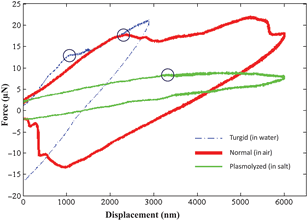Article contents
Quantifying plant cell-wall failure in vivo using nanoindentation
Published online by Cambridge University Press: 28 August 2014
Abstract

Nanoindentation experiments have been carried on Arabidopsis thaliana using spherical tungsten tips. Load–displacement plots obtained from experiments suggest that there is an optimum diameter of tip size which can be used to safely penetrate the tip through the cell wall. Based on the exact tip size used in the experiments and the measured load–displacement response, the failure stress was calculated using the experimental data in conjunction with a computational model. The value of failure stress was investigated in hypertonic (plasmolyzed), isotonic, and hypotonic (turgid) samples.
- Type
- Research Letters
- Information
- Copyright
- Copyright © Materials Research Society 2014
References
- 5
- Cited by




